The Effects of Fireworks Discharge on Atmospheric PM2.5 Concentration in the Chinese Lunar New Year
Abstract
:1. Introduction
2. Materials and Methods
2.1. Study Region and Data
- (1)
- Ground PM2.5 observations. In recent years, the Chinese government has accelerated the construction of the PM2.5 ground monitoring network. By the end of 2016, the number of online sites had reached 1600. The collection and processing of pollutant data is undertaken in accordance with the Technical Regulation on Ambient Air Quality Index (AQI) and national quality control guidelines [50,51].
- (2)
- Moderate Resolution Imaging Spectroradiometer (MODIS) aerosol optical depth (AOD) products. Compared with station observations, satellite data enjoy a wider coverage and longer observation times, which means that satellite data show significant advantages in air quality related research [52,53,54,55,56,57,58,59].In this study, MODIS Level 2 Collection 6 10-km AOD products were adopted for the national PM2.5 retrieval. The quality of MODIS AOD products has been proven to meet the requirements of atmospheric-related research [60,61,62]. The newly released 10-km AOD products in collection 6 have further enhanced the retrieval capacity in the highlighted regions by combining the dark target algorithm and deep blue algorithm in AOD retrieval. The overall correlation between Collection 6 AOD and AERONET-observed AOD over land is R = 0.86, and 69.4% of Collection 6 AOD fall within expected uncertainty of [63].The Terra and Aqua are polar-orbiting satellites and cross the equator at around 10:30 a.m. (descending orbit) and 1:30 p.m. (ascending orbit) local sun times, respectively. Since the crossing time of these two sensors is different, the data of Terra and Aqua should be combined to better represent daily AOD. For each pixel, if there is no data for both Terra and Aqua products, it was identified as “null”; if both values are identified, the average value was used; if there is only one valid value, this value was taken.
- (3)
- Meteorological data. Meteorological conditions can greatly influence the distribution of atmospheric pollutants. The NCEP GDAS/FNL 0.25 Degree Global Tropospheric Analyses and Forecast Grids product is used in this research. These data have a 6-hr temporal resolution and fully cover the research area since 1991. We extracted relative humidity (RH, %), temperature (TEMP, K), wind speed, (WS, m/s), surface pressure (SP, Pa), and height of planetary boundary layer (HPBL, m) (Table S1) and resampled them into 0.1 degree (10 km) for historical PM2.5 retrieval. Because the spatial resolution of the reanalysis data was relatively coarse, the ground monitoring data was a better choice for the detailed analysis. The daily meteorological ground observations were also used to supplement the analysis of the firework policy effects.
2.2. Historical PM2.5 Retrieval
2.3. The 17-Day Time Division Schema
2.4. The Historical PM2.5 Data Fusion Schema
3. Results
3.1. Instantaneous Effect of Fireworks Discharge on PM2.5
- (1)
- If the maximum value of PM2.5 in a city appeared during 0:00–04:00 on New Year’s Day, it was considered that the city’s PM2.5 responded significantly to the New Year fireworks.
- (2)
- If the maximum value of PM2.5 in a city did not appear during 0:00–04:00 on New Year’s Day, but both the increase and the increase rate were the highest compared with those during the 0:00–04:00 period of the remaining days, it was considered that the city’s PM2.5 responded obviously to the New Year fireworks.
- (3)
- If the variation of PM2.5 in a city did not match the above two conditions, it was considered that the city’s PM2.5 responded weakly to the New Year fireworks.
3.2. Sustained Effect of Fireworks Discharge on PM2.5
3.3. Effect of Firework Prohibition Policies
4. Discussion
5. Conclusions
Supplementary Materials
Author Contributions
Funding
Acknowledgments
Conflicts of Interest
References
- Zong, L. A Record of the Age of Jingchu; Zhonghua Book Company: Beijing, China, 1991; pp. 1–16. [Google Scholar]
- Fann, N.; Coffman, E.; Timin, B.; Kelly, J.T. The estimated change in the level and distribution of PM2.5-attributable health impacts in the United States: 2005–2014. Environ. Res. 2018, 167, 506–514. [Google Scholar] [CrossRef]
- Chai, F.H.; Gao, J.; Chen, Z.X.; Wang, S.L.; Zhang, Y.C.; Zhang, J.Q.; Zhang, H.F.; Yun, Y.R.; Ren, C. Spatial and temporal variation of particulate matter and gaseous pollutants in 26 cities in China. J. Environ. Sci. 2014, 26, 75–82. [Google Scholar] [CrossRef]
- Gurjar, B.R.; Jain, A.; Sharma, A.; Agarwal, A.; Gupta, P.; Nagpure, A.S.; Lelieveld, J. Human health risks in megacities due to air pollution. Atmos. Environ. 2010, 44, 4606–4613. [Google Scholar] [CrossRef]
- Dai, C.H.; Huang, S.J.; Peng, H.; Yi, K.X.; Zhou, Y.Y.; Qin, P.F. Particulate pollution status and its characteristics during 2015–2016 in Hunan, China. Atmos. Pollut. Res. 2019, 10, 739–748. [Google Scholar] [CrossRef]
- Liu, H.; Liu, S.; Xue, B.R.; Lv, Z.F.; Meng, Z.H.; Yang, X.F.; Xue, T.; Yu, Q.; He, K.B. Ground-level ozone pollution and its health impacts in China. Atmos. Environ. 2018, 173, 223–230. [Google Scholar] [CrossRef]
- Peng, J.; Chen, S.; Lu, H.L.; Liu, Y.X.; Wu, J.S. Spatiotemporal patterns of remotely sensed PM2.5 concentration in China from 1999 to 2011. Remote Sens. Environ. 2016, 174, 109–121. [Google Scholar] [CrossRef]
- He, J.J.; Gong, S.L.; Yu, Y.; Yu, L.J.; Wu, L.; Mao, H.J.; Song, C.B.; Zhao, S.P.; Liu, H.L.; Li, X.Y.; et al. Air pollution characteristics and their relation to meteorological conditions during 2014–2015 in major Chinese cities. Enviorn. Pollut. 2017, 223, 484–496. [Google Scholar] [CrossRef] [PubMed]
- Zhang, Y.; Li, Z.Q. Remote sensing of atmospheric fine particulate matter (PM2.5) mass concentration near the ground from satellite observation. Remote Sens. Environ. 2015, 160, 252–262. [Google Scholar] [CrossRef]
- Hu, J.L.; Wang, Y.G.; Ying, Q.; Zhang, H.L. Spatial and temporal variability of PM2.5 and PM10 over the North China Plain and the Yangtze River Delta, China. Atmos. Environ. 2014, 95, 598–609. [Google Scholar] [CrossRef]
- Ji, D.S.; Li, L.; Wang, Y.S.; Zhang, J.K.; Cheng, M.T.; Sun, Y.; Liu, Z.R.; Wang, L.L.; Tang, G.Q.; Hu, B.; et al. The heaviest particulate air-pollution episodes occurred in northern China in January, 2013: Insights gained from observation. Atmos. Environ. 2014, 92, 546–556. [Google Scholar] [CrossRef]
- Liu, T.T.; Gong, S.L.; He, J.J.; Yu, M.; Wang, Q.F.; Li, H.R.; Liu, W.; Zhang, J.; Li, L.; Wang, X.G.; et al. Attributions of meteorological and emission factors to the 2015 winter severe haze pollution episodes in China’s Jing-Jin-Ji area. Atmos. Chem. Phys. 2017, 17, 2971–2980. [Google Scholar] [CrossRef] [Green Version]
- Huang, R.J.; Zhang, Y.L.; Bozzetti, C.; Ho, K.F.; Cao, J.J.; Han, Y.M.; Daellenbach, K.R.; Slowik, J.G.; Platt, S.M.; Canonaco, F.; et al. High secondary aerosol contribution to particulate pollution during haze events in China. Nature 2014, 514, 218–222. [Google Scholar] [CrossRef] [PubMed] [Green Version]
- Cao, C.; Lee, X.H.; Liu, S.D.; Schultz, N.; Xiao, W.; Zhang, M.; Zhao, L. Urban heat islands in China enhanced by haze pollution. Nat. Commun. 2016, 7, 12509. [Google Scholar] [CrossRef] [PubMed]
- Nathaniel, R.F.; Mary, A.R.; Berkley, C.W.; Pham, T.B.T.; Sebastien, B.; Savitri, G.; Richard, K.; Sitthipong, P. An assessment of annual mortality attributable to ambient PM2.5 in Bangkok, Thailand. Int. J. Environ. Res. Public Health 2020, 17, 7298. [Google Scholar]
- Lelieveld, J.; Evans, J.S.; Fnais, M.; Giannadaki, D.; Pozzer, A. The contribution of outdoor air pollution sources to premature mortality on a global scale. Nature 2015, 525, 367. [Google Scholar] [CrossRef] [PubMed]
- Wang, J.D.; Wang, S.X.; Voorhees, A.S.; Zhao, B.; Jang, C.; Jiang, J.K.; Fu, J.S.; Ding, D.; Zhu, Y.; Hao, J.M. Assessment of short-term PM2.5-related mortality due to different emission sources in the Yangtze River Delta, China. Atmos. Environ. 2015, 123, 440–448. [Google Scholar] [CrossRef]
- Kan, H.D.; Chen, R.J.; Tong, S.L. Ambient air pollution, climate change, and population health in China. Environ. Int. 2012, 42, 10–19. [Google Scholar] [CrossRef]
- Underwood, E. The polluted brain. Science 2017, 355, 342–345. [Google Scholar] [CrossRef]
- Schwartz, J.; Neas, L.M. Fine particles are more strongly associated than coarse particles with acute respiratory health effects in schoolchildren. Epidemiology 2000, 11, 6–10. [Google Scholar] [CrossRef]
- Peters, A.; Wichmann, H.E.; Tuch, T.; Heinrich, J.; Heyder, J. Respiratory effects are associated with the number of ultrafine particles. Am. J. Resp. Crit. Care 1997, 155, 1376–1383. [Google Scholar] [CrossRef]
- Zhou, M.G.; Wang, H.D.; Zeng, X.Y.; Yin, P.; Zhu, J.; Chen, W.Q.; Li, X.H.; Wang, L.J.; Wang, L.M.; Liu, Y.N.; et al. Mortality, morbidity, and risk factors in China and its provinces, 1990–2017: A systematic analysis for the Global Burden of Disease Study 2017. Lancet 2019, 394, 1145–1158. [Google Scholar] [CrossRef] [Green Version]
- Gao, M.; Beig, G.; Song, S.J.; Zhang, H.L.; Hu, J.L.; Ying, Q.; Liang, F.C.; Liu, Y.; Wang, H.K.; Lu, X.; et al. The impact of power generation emissions on ambient PM2.5 pollution and human health in China and India. Environ. Int. 2018, 121, 250–259. [Google Scholar] [CrossRef] [PubMed]
- Wang, Y.Q.; Zhang, Y.; Schauer, J.J.; de Foy, B.; Guo, B.; Zhang, Y.X. Relative impact of emissions controls and meteorology on air pollution mitigation associated with the Asia-Pacific Economic Cooperation (APEC) conference in Beijing, China. Sci. Total Environ. 2016, 571, 1467–1476. [Google Scholar] [CrossRef] [PubMed]
- Wang, P.; Dai, X.G. “APEC Blue” association with emission control and meteorological conditions detected by multi-scale statistics. Atmos. Res. 2016, 178, 497–505. [Google Scholar] [CrossRef]
- Yang, L.X.; Cheng, S.H.; Wang, X.F.; Nie, W.; Xu, P.J.; Gao, X.M.; Yuan, C.; Wang, W.X. Source identification and health impact of PM2.5 in a heavily polluted urban atmosphere in China. Atmos. Environ. 2013, 75, 265–269. [Google Scholar] [CrossRef]
- Cai, H.Y.; Nan, Y.Q.; Zhao, Y.L.; Jiao, W.L.; Pan, K.Y. Impact of winter heating on the atmospheric pollution of northern China’s prefectural cities: Evidence from a regression discontinuity design. Ecol. Indic. 2020, 118, 106709. [Google Scholar] [CrossRef]
- Xiao, Q.Y.; Ma, Z.W.; Li, S.S.; Liu, Y. The impact of winter heating on air pollution in China. PLoS ONE 2015, 10, e0117311. [Google Scholar] [CrossRef] [Green Version]
- Li, X.G.; Wang, S.X.; Duan, L.; Hao, J.; Li, C.; Chen, Y.S.; Yang, L. Particulate and trace gas emissions from open burning of wheat straw and corn stover in China. Environ. Sci. Technol. 2007, 41, 6052–6058. [Google Scholar] [CrossRef]
- Hickey, C.; Gordon, C.; Galdanes, K.; Blaustein, M.; Horton, L.; Chillrud, S.; Ross, J.; Yinon, L.; Chen, L.C.; Gordon, T. Toxicity of particles emitted by fireworks. Part. Fibre Toxicol. 2020, 17, 28. [Google Scholar] [CrossRef]
- Dickerson, A.S.; Benson, A.F.; Buckley, B.; Chan, E.A.W. Concentrations of individual fine particulate matter components in the USA around July 4th. Air Qual. Atmos. Health 2017, 10, 349–358. [Google Scholar] [CrossRef]
- Zhang, J.M.; Yang, L.X.; Chen, J.M.; Mellouki, A.; Jiang, P.; Gao, Y.; Li, Y.Y.; Yang, Y.M.; Wang, W.X. Influence of fireworks displays on the chemical characteristics of PM2.5 in rural and suburban areas in Central and East China. Sci. Total Environ. 2017, 578, 476–484. [Google Scholar] [CrossRef] [PubMed]
- Zhang, Y.Y.; Wei, J.M.; Tang, A.H.; Zheng, A.H.; Shao, Z.X.; Liu, X.J. Chemical characteristics of PM2.5 during 2015 Spring Festival in Beijing, China. Aerosol Air Qual. Res. 2017, 17, 1169–1180. [Google Scholar] [CrossRef] [Green Version]
- Moreno, T.; Querol, X.; Alastuey, A.; Minguillón, M.C.; Pey, J.; Rodriguez, S.; Miró, J.V.; Felis, C.; Gibbons, W. Recreational atmospheric pollution episodes: Inhalable metalliferous particles from firework displays. Atmos. Environ. 2007, 41, 913–922. [Google Scholar] [CrossRef]
- Li, W.J.; Shi, Z.B.; Yan, C.; Yang, L.X.; Dong, C.; Wang, W.X. Individual metal-bearing particles in a regional haze caused by firecracker and firework emissions. Sci. Total Environ. 2013, 443, 464–469. [Google Scholar] [CrossRef] [PubMed]
- Drewnick, F.; Hings, S.S.; Curtius, J.; Eerdekens, G.; Williams, J. Measurement of fine particulate and gas-phase species during the New Year’s fireworks 2005 in Mainz, Germany. Atmos. Environ. 2006, 40, 4316–4327. [Google Scholar] [CrossRef]
- Seidel, D.J.; Birnbaum, A.N. Effects of Independence Day fireworks on atmospheric concentrations of fine particulate matter in the United States. Atmos. Environ. 2015, 115, 192–198. [Google Scholar] [CrossRef]
- Tiwari, S.; Chate, D.M.; Srivastava, M.K.; Safai, P.D.; Srivastava, A.K.; Bisht, D.S.; Padmanabhamurty, B. Statistical evaluation of PM10 and distribution of PM1, PM2.5, and PM10 in ambient air due to extreme fireworks episodes (Deepawali festivals) in megacity Delhi. Nat. Hazards 2011, 61, 521–531. [Google Scholar] [CrossRef]
- Joly, A.; Smargiassi, A.; Kosatsky, T.; Fournier, M.; Dabek-Zlotorzynska, E.; Celo, V.; Mathieu, D.; Servranckx, R.; D’Amours, R.; Malo, A.; et al. Characterization of particulate exposure during fireworks displays. Atmos. Environ. 2010, 44, 4325–4329. [Google Scholar] [CrossRef]
- Liu, B.; Wu, C.; Ma, N.; Chen, Q.; Li, Y.W.; Ye, J.H.; Martin, S.T.; Li, Y.J. Vertical profiling of fine particulate matter and black carbon by using unmanned aerial vehicle in Macau, China. Sci. Total Environ. 2020, 709, 136109. [Google Scholar] [CrossRef]
- Singh, A.; Pant, P.; Pope, F.D. Air quality during and after festivals: Aerosol concentrations, composition and health effects. Atmos. Res. 2019, 227, 220–232. [Google Scholar] [CrossRef]
- Shen, H.Z.; Lu, C.C.; Jiang, Y.B.; Yuan, C.S.; Jing, G.H.; Hu, G.R.; Yu, R.L. Chemical Composition and Health Risk of PM2.5 by Near-ground Firecracker Burning in Micro Region of Eastern Taiwan. Aerosol Air Qual. Res. 2019, 19, 2252–2266. [Google Scholar] [CrossRef]
- Ye, C.; Chen, R.S.; Chen, M.X. The impacts of Chinese Nian culture on air pollution. J. Clean. Prod. 2016, 112, 1740–1745. [Google Scholar] [CrossRef]
- Ye, C.; Chen, R.S.; Young, C. Nian: When Chinese mythology affects air pollution. Lancet 2014, 383, 2125. [Google Scholar] [CrossRef]
- Huang, K.; Zhuang, G.; Lin, Y.; Wang, Q.; Fu, J.S.; Zhang, R.; Li, J.; Deng, C.; Fu, Q. Impact of anthropogenic emission on air quality over a megacity-revealed from an intensive atmospheric campaign during the Chinese Spring Festival. Atmos. Chem. Phys. 2012, 12, 11631–11645. [Google Scholar] [CrossRef] [Green Version]
- China News: The Fireworks Party Held in Guangzhou for 18 Years Was Stopped, Which Triggered a Discussion of the Downplay of New Year’s Customs. Available online: http://www.chinanews.com/gn/2013/02-12/4562167.shtml (accessed on 10 October 2020).
- CCTV: Chinese Lunar New Year Firework Residules Were Reduced more than a Thousand Tons during the 8-Day New Year Celebration in Beijing. Available online: http://news.cntv.cn/2013/02/16/VIDE1360993172699520.shtml (accessed on 11 November 2020).
- Wang, Y.; Zhuang, G.S.; Xu, C.; An, Z.S. The air pollution caused by the burning of fireworks during the lantern festival in Beijing. Atmos. Environ. 2007, 41, 417–431. [Google Scholar] [CrossRef]
- Han, G.; Gong, W.; Quan, J.H.; Li, J.; Zhang, M. Spatial and temporal distributions of contaminants emitted because of Chinese New Year’s Eve celebrations in Wuhan. Environ. Sci. Process. Impacts 2014, 16, 916–923. [Google Scholar] [CrossRef] [PubMed]
- Ministry of Ecology and Environment of the People’s Republic of China: Technical Regulation for Ambient Air Quality Assessment (HJ663-2013). Available online: http://www.mee.gov.cn/gkml/hbb/bgg/201309/t20130925_260801.htm (accessed on 10 October 2020).
- Ministry of Ecology and Environment of the People’s Republic of China: Ambient Air Quality Standards (GB3095–2012). Available online: http://www.mee.gov.cn/ywgz/fgbz/bz/bzwb/dqhjbh/dqhjzlbz/201203/t20120302_224165.htm (accessed on 10 October 2020).
- Yuan, Q.Q.; Shen, H.F.; Li, T.W.; Li, Z.W.; Li, S.W.; Jiang, Y.; Xu, H.Z.; Tan, W.W.; Yang, Q.Q.; Wang, J.W.; et al. Deep learning in environmental remote sensing: Achievements and challenges. Remote Sens. Environ. 2020, 241, 111716. [Google Scholar] [CrossRef]
- Xue, T.; Zheng, Y.X.; Tong, D.; Zheng, B.; Li, X.; Zhu, T.; Zhang, Q. Spatiotemporal continuous estimates of PM2.5 concentrations in China, 2000-2016: A machine learning method with inputs from satellites, chemical transport mosdel, and ground observations. Environ. Int. 2019, 123, 345–357. [Google Scholar] [CrossRef]
- Ma, Z.W.; Hu, X.F.; Sayer, A.M.; Levy, R.; Zhang, Q.; Xue, Y.G.; Tong, S.L.; Bi, J.; Huang, L.; Liu, Y. Satellite-Based Spatiotemporal Trends in PM2.5 Concentrations: China, 2004–2013. Environ. Health Persp. 2016, 124, 184–192. [Google Scholar] [CrossRef] [Green Version]
- Xie, Y.Y.; Wang, Y.X.; Zhang, K.; Dong, W.H.; Lv, B.L.; Bai, Y.Q. Daily Estimation of Ground-Level PM2.5 Concentrations over Beijing Using 3 km Resolution MODIS AOD. Environ. Sci. Technol. 2015, 49, 12280–12288. [Google Scholar] [CrossRef] [Green Version]
- Song, W.Z.; Jia, H.F.; Huang, J.F.; Zhang, Y.Y. A satellite-based geographically weighted regression model for regional PM2.5 estimation over the Pearl River Delta region in China. Remote Sens. Environ. 2014, 154, 1–7. [Google Scholar] [CrossRef]
- Gupta, P.; Christopher, S.A. Seven year particulate matter air quality assessment from surface and satellite measurements. Atmos. Chem. Phys. 2008, 8, 3311–3324. [Google Scholar] [CrossRef] [Green Version]
- van Donkelaar, A.; Martin, R.V.; Park, R.J. Estimating ground-level PM2.5 using aerosol optical depth determined from satellite remote sensing. J. Geophys. Res. 2006, 111, D21201. [Google Scholar] [CrossRef]
- Wang, J.; Christopher, S.A. Intercomparison between satellite-derived aerosol optical thickness and PM2.5 mass: Implications for air quality studies. Geophys. Res. Lett. 2003, 30, 2095. [Google Scholar] [CrossRef]
- Sorek-Hamer, M.; Kloog, I.; Koutrakis, P.; Strawa, A.W.; Chatfield, R.; Cohen, A.; Ridgway, W.L.; Broday, D.M. Assessment of PM2.5 concentrations over bright surfaces using MODIS satellite observations. Remote Sens. Environ. 2015, 163, 180–185. [Google Scholar] [CrossRef]
- Tsai, T.C.; Jeng, Y.J.; Chu, D.A.; Chen, J.P.; Chang, S.C. Analysis of the relationship between MODIS aerosol optical depth and particulate matter from 2006 to 2008. Atmos. Environ. 2011, 45, 4777–4788. [Google Scholar] [CrossRef]
- Hutchison, K.D. Applications of MODIS satellite data and products for monitoring air quality in the state of Texas. Atmos. Environ. 2003, 37, 2403–2412. [Google Scholar] [CrossRef]
- Levy, R.C.; Mattoo, S.; Munchak, L.A.; Remer, L.A.; Sayer, A.M.; Patadia, F.; Hsu, N.C. The Collection 6 MODIS aerosol products over land and ocean. Atmos. Meas. Tech. 2013, 6, 2989–3034. [Google Scholar] [CrossRef] [Green Version]
- Geng, G.N.; Zhang, Q.; Martin, R.V.; van Donkelaar, A.; Huo, H.; Chen, H.Z.; Lin, J.T.; He, K.B. Estimating long-term PM2.5 concentrations in China using satellite-based aerosol optical depth and a chemical transport model. Remote Sens. Environ. 2015, 166, 262–270. [Google Scholar] [CrossRef]
- Lin, C.M.; Chung, C.C. Fuzzy brain emotional learning control system design for nonlinear systems. Int. J. Fuzzy Syst. 2015, 17, 117–128. [Google Scholar] [CrossRef]
- Liu, Y.; Sarnat, J.A.; Coull, B.A.; Koutrakis, P.; Jacob, D.J. Validation of multiangle imaging spectroradiometer (MISR) aerosol optical thickness measurements using aerosol robotic network (AERONET) observations over the contiguous United States. J. Geophys. Res. Atmos. 2004, 109, D06205. [Google Scholar] [CrossRef]
- Gupta, P.; Christopher, S.A. Particulate matter air quality assessment using integrated surface, satellite, and meteorological products: 2. A neural network approach. J. Geophys. Res. 2009, 114, D20205. [Google Scholar] [CrossRef]
- You, W.; Zang, Z.L.; Zhang, L.F.; Li, Z.J.; Chen, D.; Zhang, G. Estimating ground-level PM10 concentration in northwestern China using geographically weighted regression based on satellite AOD combined with CALIPSO and MODIS fire count. Remote Sens. Environ. 2015, 168, 276–285. [Google Scholar] [CrossRef]
- Benas, N.; Beloconi, A.; Chrysoulakis, N. Estimation of urban PM10 concentration, based on MODIS and MERIS/AATSR synergistic observations. Atmos. Environ. 2013, 79, 448–454. [Google Scholar] [CrossRef]
- Tian, J.; Chen, D.M. A semi-empirical model for predicting hourly ground-level fine particulate matter (PM2.5) concentration in southern Ontario from satellite remote sensing and ground-based meteorological measurements. Remote Sens. Environ. 2010, 114, 221–229. [Google Scholar] [CrossRef]
- Wang, Z.F.; Chen, L.F.; Tao, J.H.; Zhang, Y.; Su, L. Satellite-based estimation of regional particulate matter (PM) in Beijing using vertical-and-RH correcting method. Remote Sens. Environ. 2010, 114, 50–63. [Google Scholar] [CrossRef]
- Yao, L.; Lu, N. Spatiotemporal distribution and short-term trends of particulate matter concentration over China, 2006–2010. Environ. Sci. Pollut. Res. 2014, 21, 9665–9675. [Google Scholar] [CrossRef]
- Wu, Y.R.; Guo, J.P.; Zhang, X.Y.; Tian, X.; Zhang, J.H.; Wang, Y.Q.; Duan, J.; Li, X.W. Synergy of satellite and ground based observations in estimation of particulate matter in eastern China. Sci. Total Environ. 2012, 433, 20–30. [Google Scholar] [CrossRef]
- Gardner, M.W.; Dorling, S.R. Artificial neural networks (the multilayer perceptron)—A review of application in the atmospheric sciences. Atmos. Environ. 1998, 32, 2627–2636. [Google Scholar] [CrossRef]
- Li, T.W.; Shen, H.F.; Zeng, C.; Yuan, Q.Q.; Zhang, L.P. Point-surface fusion of station measurements and satellite observations for mapping PM2.5 distribution in China: Methods and assessment. Atmos. Environ. 2017, 152, 477–489. [Google Scholar] [CrossRef] [Green Version]
- Rodriguez, J.D.; Perez, A.; Lozano, J.A. Sensitivity analysis of k-fold cross validation in prediction error estimation. IEEE Trans. Pattern Anal. Mach. Intell. 2010, 32, 569–575. [Google Scholar] [CrossRef] [PubMed]
- Li, T.W.; Shen, H.F.; Zeng, C.; Yuan, Q.Q. A Validation approach considering the uneven distribution of ground stations for satellite-based PM2.5 estimation. IEEE J. Sel. Top. Appl. Earth Obs. Remote Sens. 2020, 13, 1312–1321. [Google Scholar] [CrossRef]
- Liu, Z.R.; Hu, B.; Wang, L.L.; Wu, F.K.; Gao, W.K.; Wang, Y.S. Seasonal and diurnal variation in particulate matter (PM10 and PM2.5) at an urban site of Beijing: Analyses from a 9-year study. Environ. Sci. Pollut. Res. 2015, 22, 627–642. [Google Scholar] [CrossRef] [PubMed]
- Li, Q.; Zhang, R.H.; Wang, Y. Interannual variation of the wintertime fog-haze days across central and eastern China and its relation with East Asian winter monsoon. Int. J. Climatol. 2016, 36, 346–354. [Google Scholar] [CrossRef]
- He, K.B.; Yang, F.M.; Ma, Y.L.; Zhang, Q.; Yao, X.H.; Chan, C.K.; Cadle, S.; Chan, T.; Mulawa, P. The characteristics of PM2.5 in Beijing, China. Atmos. Environ. 2001, 35, 4959–4970. [Google Scholar] [CrossRef]
- Tan, P.H.; Chou, C.; Liang, J.Y.; Chou, C.C.K.; Shiu, C.J. Air pollution “holiday effect” resulting from the Chinese New Year. Atmos. Environ. 2009, 43, 2114–2124. [Google Scholar] [CrossRef]
- Li, T.W.; Shen, H.F.; Yuan, Q.Q.; Zhang, X.C.; Zhang, L.P. Estimating ground-level PM2.5 by fusing satellite and station observations: A geo-intelligent deep learning approach. Geophys. Res. Lett. 2017, 44, 11985–11993. [Google Scholar] [CrossRef] [Green Version]
- Fang, X.; Zou, B.; Liu, X.P.; Sternberg, T.; Zhai, L. Satellite-based ground PM2.5 estimation using timely structure adaptive modeling. Remote Sens. Environ. 2016, 186, 152–163. [Google Scholar] [CrossRef]
- Yang, M.; Fan, H.; Zhao, K. Fine-grained spatiotemporal analysis of the impact of restricting factories, motor vehicles, and fireworks on air pollution. Int. J. Environ. Res. Public Health 2020, 17, 4828. [Google Scholar] [CrossRef]
- Sichuan News: During the Chinese New Year Period in the Past Five Years in Chengdu, the Worst Air Quality Appears in 2014 and Best Appears in 2013. Available online: http://scnews.newssc.org/system/20140211/000176134.html (accessed on 10 October 2020).
- Cai, W.J.; Li, K.; Liao, H.; Wang, H.J.; Wu, L.X. Weather conditions conducive to Beijing severe haze more frequent under climate change. Nat. Clim. Chang. 2017, 7, 257. [Google Scholar] [CrossRef]
- Souhu.com: Whether the Chinese New Year Firework Prohibition Policies will Affect the Cultural Heritage. Available online: http://news.sohu.com/2004/01/05/55/news217955534.shtml (accessed on 10 October 2020).
- Hubei Sina: Since Shiyan Implemented Firework Prohibition Policy, 142 People have been Fined for Illegally Discharge Fireworks. Available online: http://hb.sina.com.cn/news/j/2014-01-10/1424136281_2.html (accessed on 10 October 2020).
- Meng, F.H.; Wang, J.; Li, T.N.; Fang, C.S. Pollution characteristics, transport pathways, and potential source regions of PM2.5 and PM10 in Changchun City in 2018. Int. J. Enviorn. Res. Public Health 2020, 17, 6585. [Google Scholar] [CrossRef] [PubMed]
- China National Environmental Monitoring Centre: National City Air Quality Real-Time Data. Available online: http://106.37.208.233:20035 (accessed on 10 October 2020).
- National Meteorological Information Center: China Surface Daily Meteorological Data Set (V3.0). Available online: http://data.cma.cn/data/cdcdetail/dataCode/SURF_CLI_CHN_MUL_DAY_CES_V3.0.html (accessed on 10 October 2020).
- National Centers for Environmental Prediction, National Weather Service, NOAA, U.S. Department of Commerce: NCEP GDAS/FNL 0.25 Degree Global Tropospheric Analyses and Forecast Grids. Research Data Archive at the National Center for Atmospheric Research, Computational and Information Systems Laboratory: Boulder, CO, USA. Available online: https://doi.org/10.5065/D65Q4T4Z (accessed on 10 October 2020).
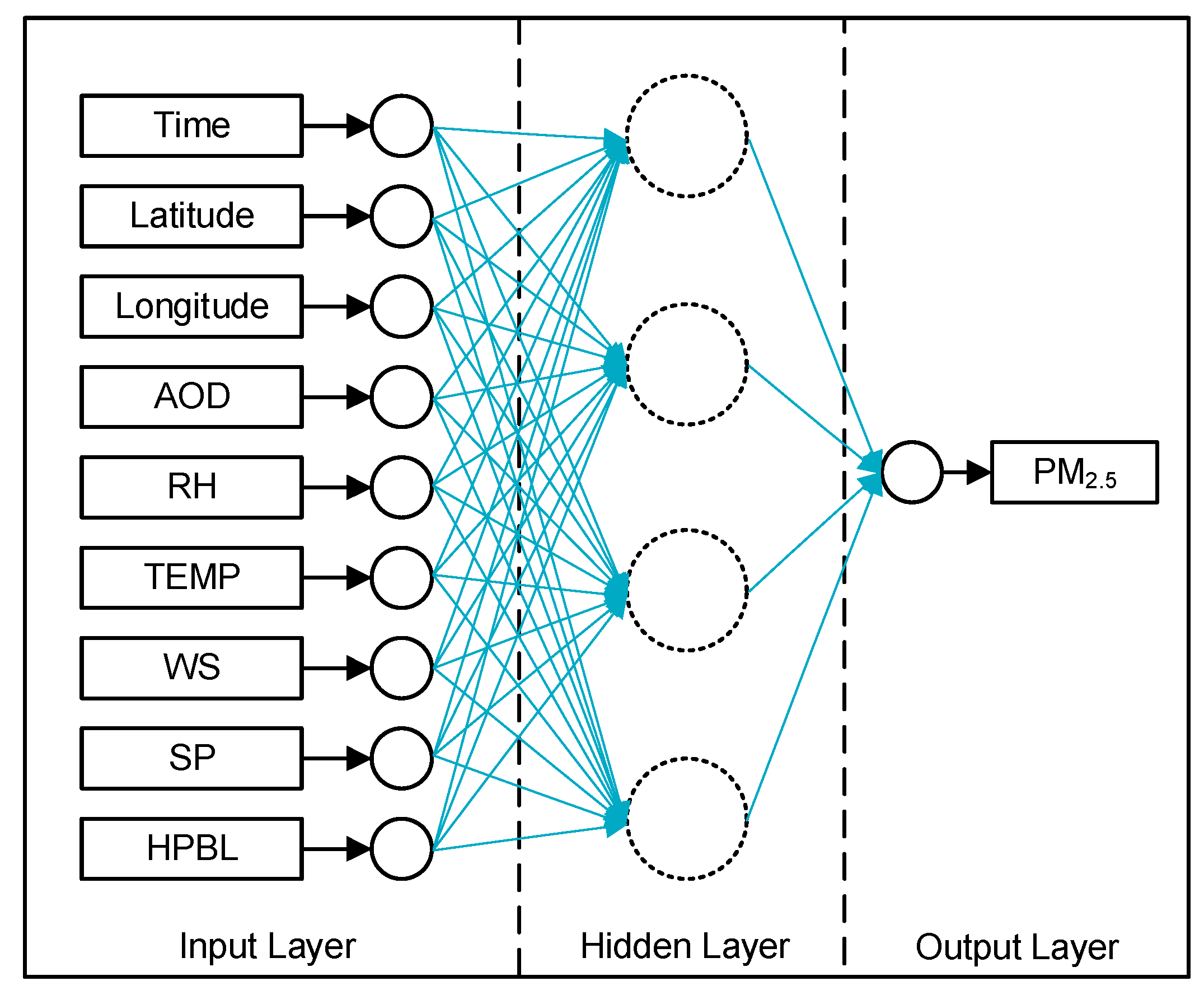

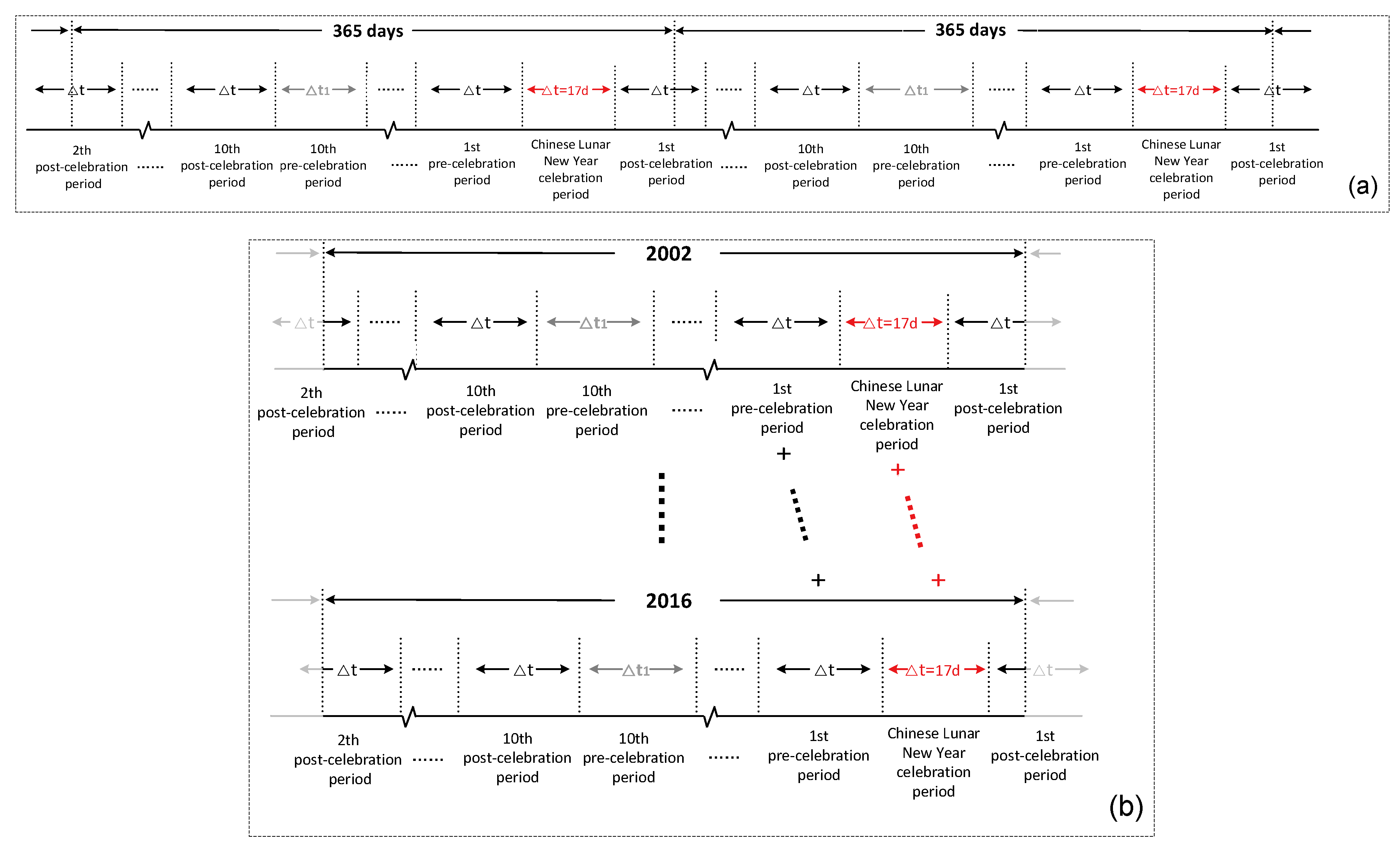

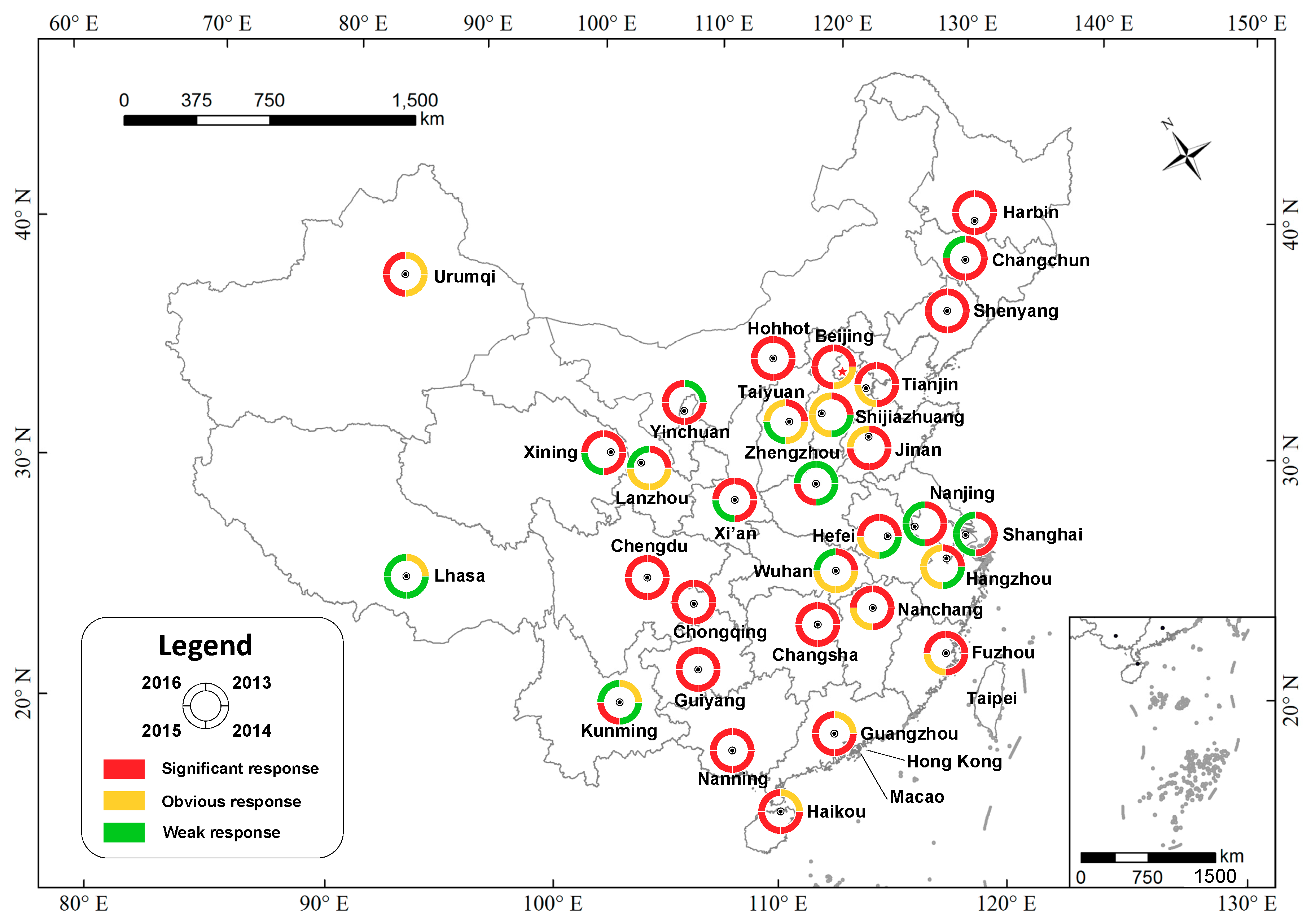
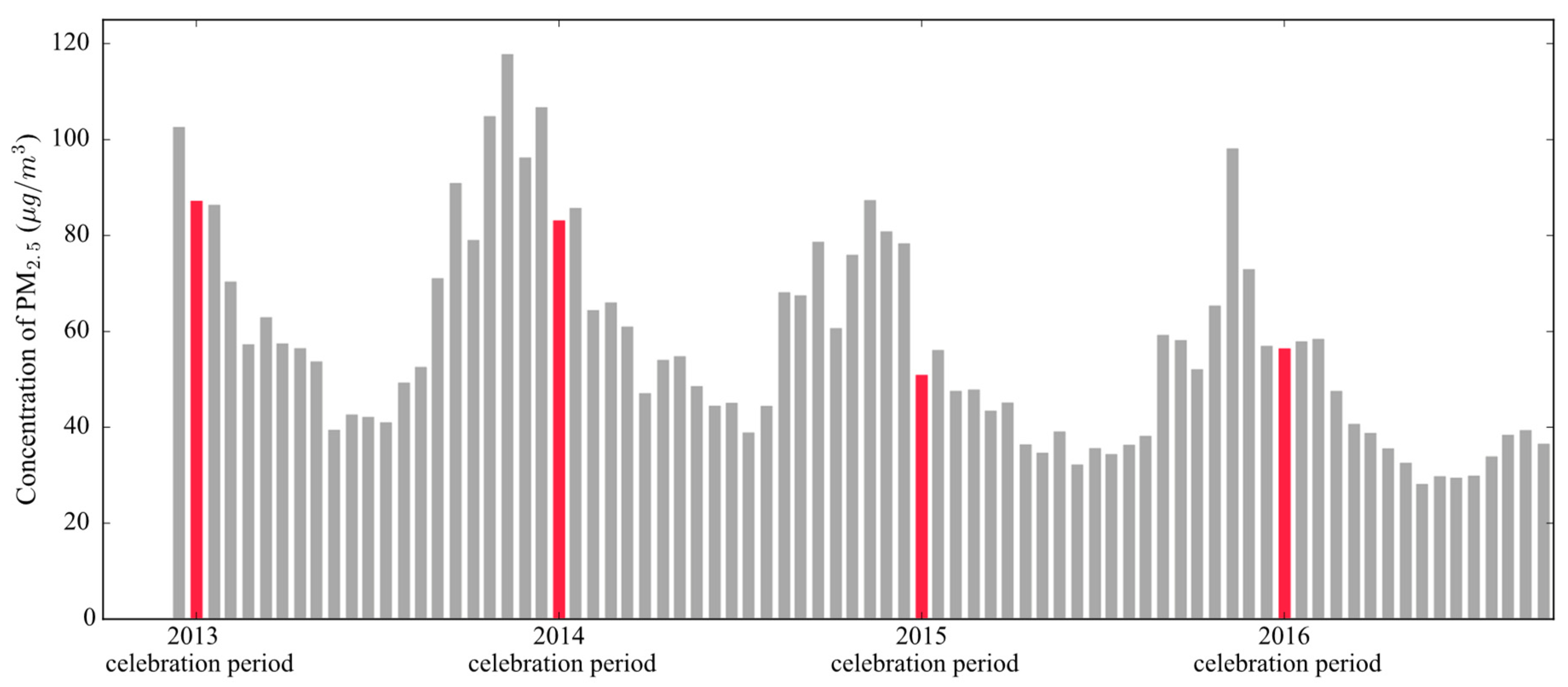
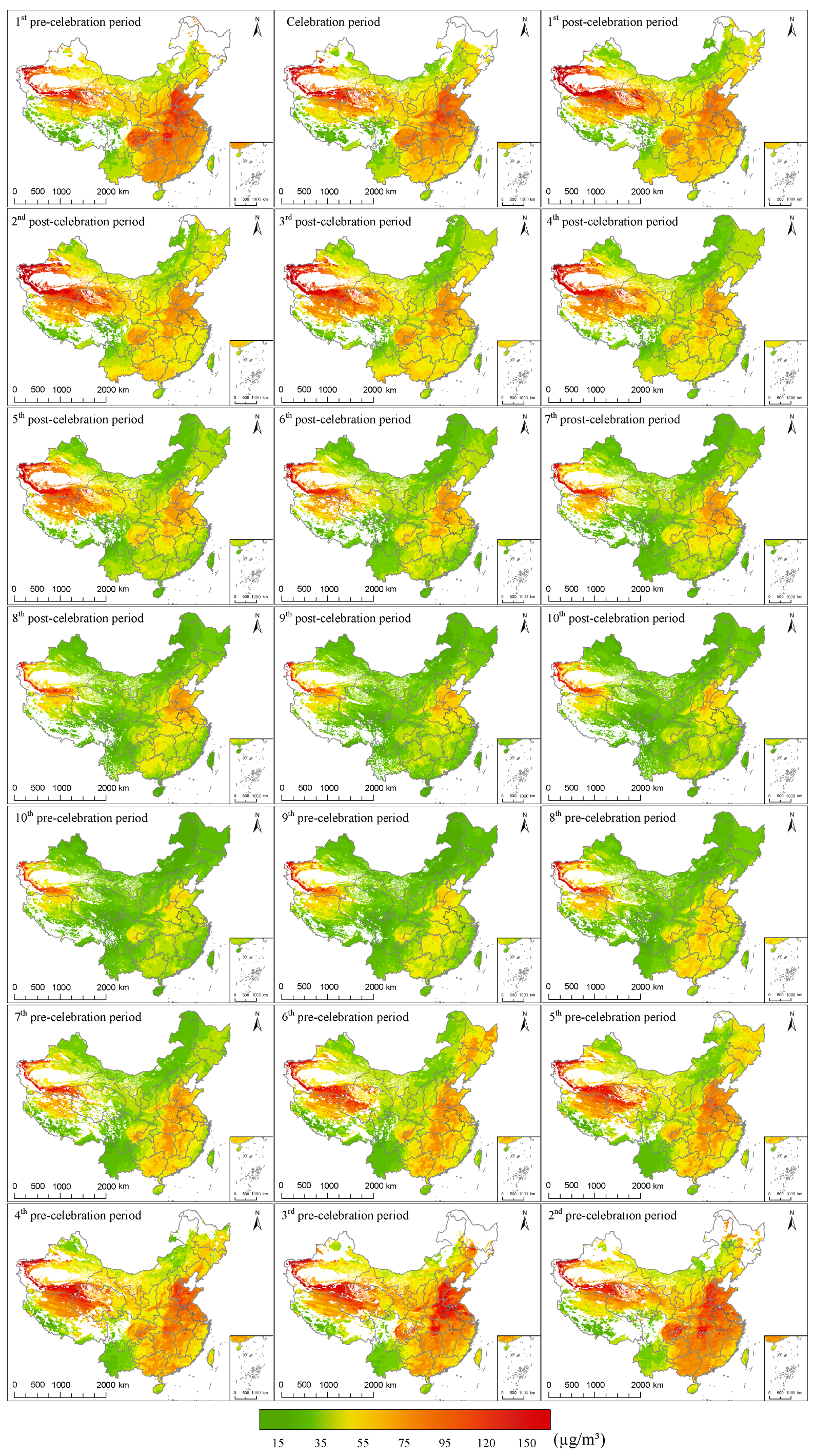
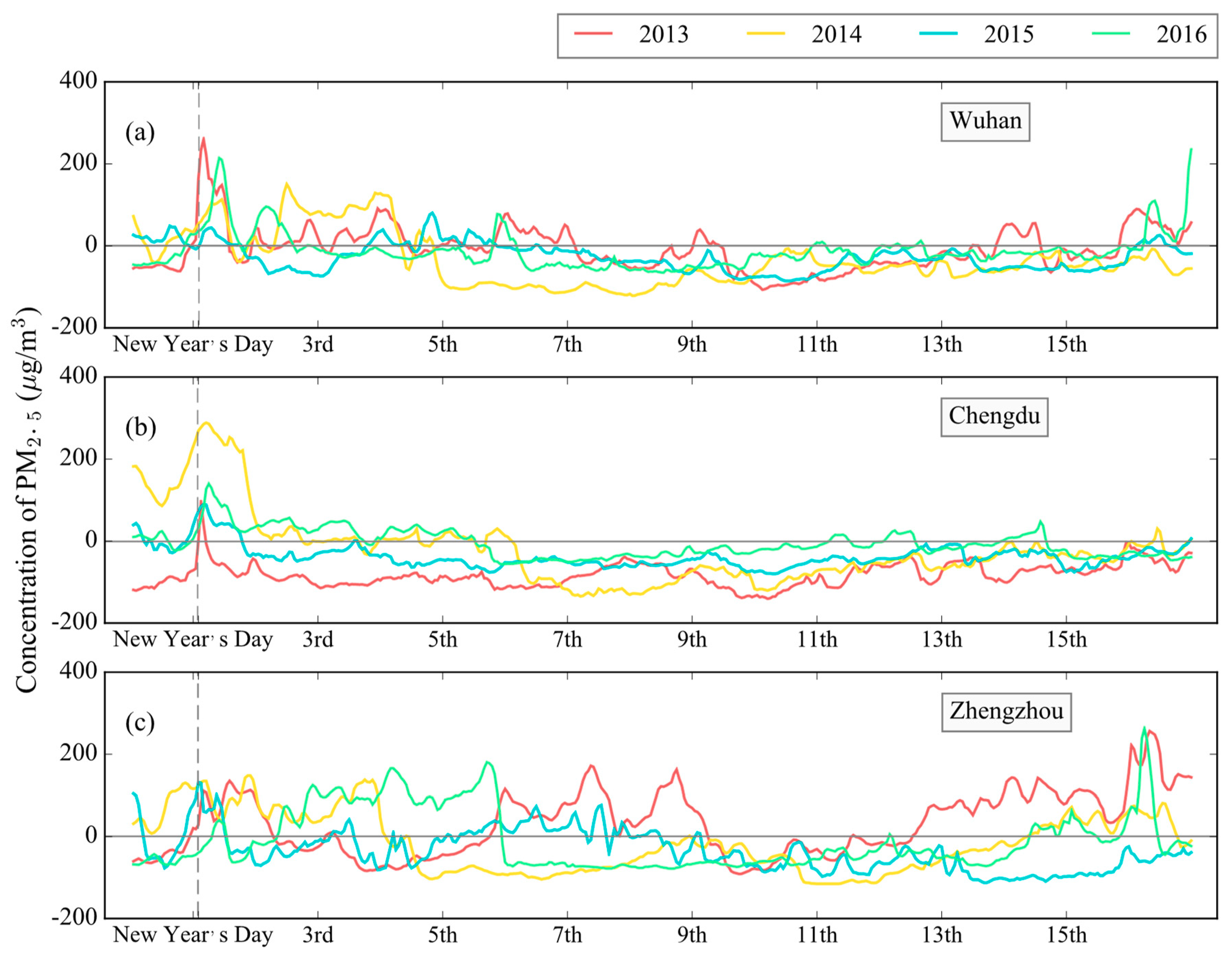
Publisher’s Note: MDPI stays neutral with regard to jurisdictional claims in published maps and institutional affiliations. |
© 2020 by the authors. Licensee MDPI, Basel, Switzerland. This article is an open access article distributed under the terms and conditions of the Creative Commons Attribution (CC BY) license (http://creativecommons.org/licenses/by/4.0/).
Share and Cite
Zhang, X.; Shen, H.; Li, T.; Zhang, L. The Effects of Fireworks Discharge on Atmospheric PM2.5 Concentration in the Chinese Lunar New Year. Int. J. Environ. Res. Public Health 2020, 17, 9333. https://doi.org/10.3390/ijerph17249333
Zhang X, Shen H, Li T, Zhang L. The Effects of Fireworks Discharge on Atmospheric PM2.5 Concentration in the Chinese Lunar New Year. International Journal of Environmental Research and Public Health. 2020; 17(24):9333. https://doi.org/10.3390/ijerph17249333
Chicago/Turabian StyleZhang, Xuechen, Huanfeng Shen, Tongwen Li, and Liangpei Zhang. 2020. "The Effects of Fireworks Discharge on Atmospheric PM2.5 Concentration in the Chinese Lunar New Year" International Journal of Environmental Research and Public Health 17, no. 24: 9333. https://doi.org/10.3390/ijerph17249333
APA StyleZhang, X., Shen, H., Li, T., & Zhang, L. (2020). The Effects of Fireworks Discharge on Atmospheric PM2.5 Concentration in the Chinese Lunar New Year. International Journal of Environmental Research and Public Health, 17(24), 9333. https://doi.org/10.3390/ijerph17249333






